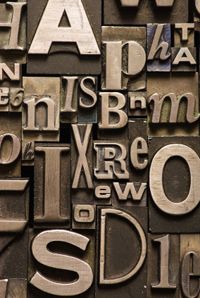
We take great pride in making our clients feel confident about their jobs during the production process. To help you gain a better understanding of what’s happening to your project, we’ve compiled a glossary of terms that we commonly use in our industry.
-
Accordion Fold
A type of paper folding in which each fold runs in the opposite direction to the previous fold creating a pleated or accordion effect.
-
Alkali Blue
Also called reflex blue. A pigment used in carbon black inks and varnishes to improve luster.
-
Aqueous Plate
Water soluble plate coatings, which are less toxic and less polluting.
-
Binding
Various methods of securing folded sections together and or fastening them to a cover, to form single copies of a book.
-
Blanket
On offset presses a fabric-reinforced sheet of rubber to transfer the impression from the plate onto the paper.
-
Bleed
Extra ink area that crosses trim line, used to allow for variations that occur when the reproduction is trimmed or die-cut.
-
Bulk
A term used to define the number of pages per inch of a book relative to its given basis weight.
-
Coated Stock
Any paper that has a mineral coating applied after the paper is made, giving the paper a smoother finish.
-
Collate
To gather sheets or signatures together in their correct order. (see Gather)
-
Collating Marks
Black step-marks printed on the back of folded sheets, to facilitate collating and checking of the sequence of book signatures.
-
Color Bars
This term refers to a color test strip, which is printed on the waste portion of a press sheet. It is a standardized (GATF-Graphic Arts Technical Foundation) process which allows a pressman to determine the quality of the printed material relative to ink density, registration, and dot gain. It also includes the Star Target, which is a similar system designed to detect inking problems.
-
Creep
When the rubber blanket on a cylinder moves forward due to contact with the plate or paper. Result of added thickness of folded sheets being behind one another in a folded signature. Outer edges of sheets creep away from back most fold as more folded sheets are inserted inside the middle.
-
Crop
To eliminate a portion of the art or copy as indicated by crop marks.
-
Crop Mark
Markings at edges of original or on guide sheet to indicate the area desired in reproduction with negative or plate trimmed (cropped) at the markings.
-
Crossover
A term used to describe the effect of ink from an image, rule or line art on one printed page, which carries over to another page of a bound work.
-
Deckle Edge
The rough or feathered edge of paper when left untrimmed.
-
Die Cutting
A method of using sharp steel ruled stamps or rollers to cut various shapes i.e. labels, boxes, image shapes, either post press or in line. The process of cutting paper in a shape or design by the use of a wooden die or block in which are positioned steel rules in the shape of the desired pattern.
-
Digital Proof
Color separation data is digitally stored and then exposed to color photographic paper creating a picture of the final product before it is actually printed.
-
Dull Finish
Any matte finished paper.
-
Embossed
A method of paper finishing whereby a pattern is pressed into the paper when it is dry.
-
Embossing
To raise in relief a design or letters already printed on card stock or heavy paper by an uninked block or die. In rubber and plastic plate making the process is usually done by heat.
-
English Finish
A grade of uncoated book paper with a smooth uniform surface.
-
Estimate
The form used by the printer to calculate the project for the print buyer. This form contains the basic parameters of the project including size, quantity, colors, bleeds, photos etc.
-
Etch
The process of producing an image on a plate by the use of acid.
-
Fan Fold
Paper folding that emulates an accordion or fan, the folds being alternating and parallel.
-
Film Coat
Also called wash coat; any thinly coated paper stock.
-
Ganging
The bundling of two or more different printing projects on the same sheet of paper.
-
Ghosting
Image which appears as a lighter area on a subsequent print due to local blanket depressions from previous image areas on a letterpress rotary machine as well as on an offset press.
-
Grain
Direction of fibers in a sheet of paper governing paper properties such as increased size changes with relative humidity, across the grain, and better folding properties along the grain.
-
Gripper
A series of metal fingers that hold each sheet of paper as it passes through the various stages of the printing process.
-
Gutter
Space between pages in the printing frame of a book, or inside margin towards the back or binding edge. The blank space or margin between the type page and the binding of a book.
-
Hickies
Imperfections in presswork due to dirt on press, trapping errors, etc.
-
House Sheet
This is a term that refers to a paper that a printer keeps on hand in his shop.
-
Indicia
Markings pre-printed on mailing envelopes to replace the stamp.
-
Laid Finish
A parallel lined paper that has a handmade look.
-
Layout
A rendition that shows the placement of all the elements, roughs, thumbnails etc., of the final printed piece before it goes to print.
-
Linen
A paper that emulates the look and texture of linen cloth.
-
Margin
Imprinted space around edge of page.
-
Matte Finish
A coated paper finish that goes through minimal calendaring. Reference, calendaring.
-
Offset
The most commonly used printing method, whereby the printed material does not receive the ink directly from the printing plate but from an intermediary cylinder called a blanket which receives the ink from the plate and transfers it to the paper.
-
Opaque
A quality of paper that allows relatively little light to pass through.
-
Perfect Binding
Binding process where backs of sections are cut off, roughened and glued together, and rung in a cover.
-
Perforating
Punching small holes or slits in a sheet of paper or cardboard to facilitate tearing along a desired line.
-
Plate
Reproduction of type or cuts in metal, plastic, rubber, or other material, to form a plate bearing a relief, planographic or intaglio printing surface.
-
Press-Proof
Actual press sheet to show image, tone values and colors as well as imposition of frame or press-plate.
-
Process Printing
Printing from two or more half tones to produce intermediate colors and shades.
-
Proof
Impression from composed type or blocks, taken for checking and correction, from a lithographic plate to check accuracy of layout, type matter, tone and color reproduction.
-
Right Angle Fold
A term that denotes folds that are 90 degrees to each other.
-
Saddle Stitching
Stitching where the wire staples pass through the spine from the outside and are clinched in the center. Only used with folded sections, either single sections or two or more sections inset to form a single section.
-
Satin Finish
A smooth delicately embossed finished paper with sheen.
-
Score
Impressions or cuts in flat material to facilitate bending or tearing.
-
Side Stitching
Stitching where the wire staples pass through the pile of sections or leaves gathered upon each other and are clinched on the underside.
-
Slitting
A term to describe the process of cutting of printed sheets by the cutting wheels of a printing press.
-
Spiral Bind
A binding whereby a wire or plastic is spiraled through holes punched along the binding side.
-
Stripping
Originally, the removal of the photographic emulsion with its image from individual negatives and combining them in position on a glass plate. Now the use of stripfilm materials, and the cutting, attachment, and other operations for assembling. The positioning of positives and negatives on the flat before proceeding to platemaking.
-
Text
A high quality printing paper.
-
Trapping
The process of printing wet ink over printed ink which may be wet or dry.
-
Varnish
A clear shiny ink used to add gloss to printed pieces. The primary component of the ink vehicle. Reference, vehicle.
-
Vellum
A finish of paper that is rough, bulky and has a degree of tooth.




